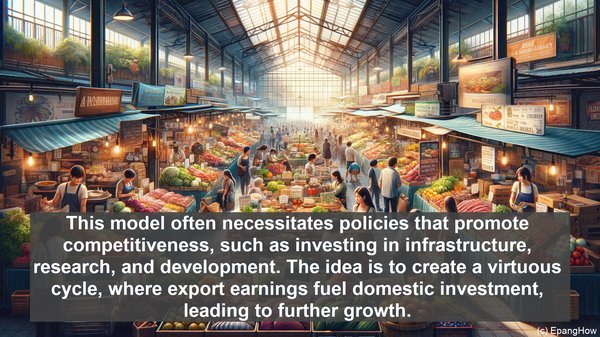Introduction: Unveiling Two Economic Paradigms
Greetings, audience! Today, we embark on a journey through the realms of economic theory, as we compare and contrast the export-led growth model and import substitution model. These two paradigms have shaped the strategies of nations, steering their paths to development. Let’s begin!
Export-Led Growth Model: Fostering Global Market Integration
The export-led growth model, as the name suggests, hinges on a nation’s ability to boost its exports. By specializing in certain industries or products, countries can tap into global demand, expanding their markets. This model often necessitates policies that promote competitiveness, such as investing in infrastructure, research, and development. The idea is to create a virtuous cycle, where export earnings fuel domestic investment, leading to further growth.

Import Substitution Model: Prioritizing Self-Sufficiency
In contrast, the import substitution model emphasizes reducing a nation’s reliance on imports. It advocates for domestic production of goods that were previously imported, aiming to bolster local industries. By doing so, countries can reduce their trade deficits, enhance employment opportunities, and nurture a self-sufficient economy. This model often calls for protective measures, such as tariffs or quotas, to shield domestic industries during the transition phase.
Divergent Goals: Balancing Priorities
While the export-led growth model focuses on integrating into the global market, the import substitution model prioritizes internal development. The former seeks to harness the advantages of international trade, while the latter aims to safeguard national interests. Consequently, the strategies, policies, and even the industries that thrive under these models can differ significantly.
Benefits and Challenges: Weighing the Trade-Offs
The export-led growth model offers the potential for rapid economic expansion, as it taps into the vast global market. It can attract foreign direct investment, foster technological advancements, and create employment opportunities. However, it also exposes a country to external shocks, such as global recessions or shifts in demand. On the other hand, the import substitution model provides a degree of economic autonomy, reducing vulnerability to global fluctuations. Yet, it can be challenging to achieve the same level of efficiency and competitiveness as established global players.

Relevance Today: Evolving Strategies
In today’s interconnected world, the dichotomy between these models has become less pronounced. Many countries adopt a hybrid approach, combining elements of both paradigms. They strive to integrate into the global market while safeguarding key industries. Moreover, the rise of regional trade agreements and the emergence of new economic powerhouses have necessitated a reevaluation of traditional models. Flexibility and adaptability are now crucial, as nations navigate the complexities of the global economy.
